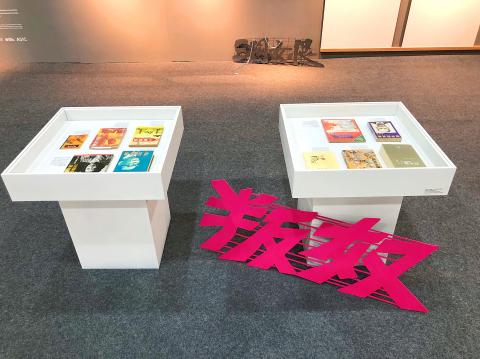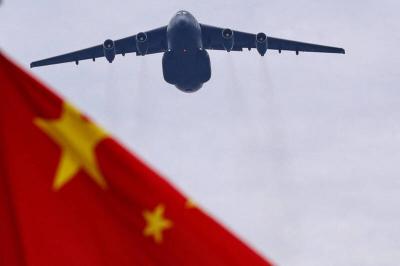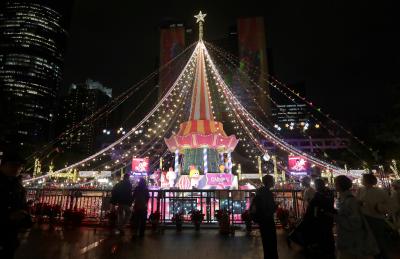Books that were banned in Taiwan during the White Terror era were displayed at the Seoul International Book Fair, which closed yesterday.
The Taipei International Book Exhibition Foundation contributed to the “Banned Books: Spirits from the Bamboo Grove” exhibition at the invitation of the fair, alongside publishers’ associations from Japan, Malaysia, Thailand and Turkey, as well as Seoul National University.
The chief planners of the Taiwanese content were publisher and former presidential adviser Rex How (郝明義), who is also the foundation’s managing supervisor, and Liao Wei-min (廖為民), who wrote The Story of Banned Books in Taiwan (台灣禁書的故事).

Photo courtesy of the Taipei International Book Exhibition Foundation
The organizations collaborated to display the formerly forbidden books to contextualize the history of literary censorship in Asia and to highlight the importance of freedom of the press, How said on Thursday.
Books on display were selected from the vast array of works proscribed during the White Terror era, or the period from 1949 to 1987 when the then-Chinese Nationalist Party (KMT) government ruled via martial law, he said.
The selection was a cross-section of the government’s press censorship, he said.
The government suppressed works of communist literature, such as Karl Marx’s Das Kapital and The Communist Manifesto, and books written by intellectuals who stayed in China after 1949, such as Lu Xun’s (魯迅) The True Story of Ah-Q (阿Q正傳) and Lao She’s (老社) Rickshaw Boy (駱駝祥子), he said.
The Legends of the Condor Heroes (射鵰英雄傳), a Wuxia novel — a genre of fiction about martial artists in ancient China — was banned because its author, Hong Konger Jin Yong (金庸), was suspected of having leftist sympathies and ties to Beijing, How said.
Books whose subject matter touched upon the 228 Massacre or the Japanese colonial era were banned, such as Su Ben’s (史明) Taiwan’s 400 Year History (台灣人四百年史), or books written by liberals who the government persecuted, including Lei Chen (雷震) and Yin Hai-kuang (殷海光), he said.
Chiang Kai-shek (蔣介石) and his son and successor Chiang Ching-kuo (蔣經國) also banned books by people who they held grudges against, such as Bo Yang (柏楊) and Chiang Nan (江南), he said.
Li Ai’s (李敖) books were banned because he was known for spurning authority, while An Anthology of Dangwai Literature (黨外文選) by Yao Chia-wen (姚嘉文) and Chen Chu (陳菊) was banned for being political literature originating from outside the KMT, he said.
The government also suppressed works deemed to challenge traditional sexual mores, such as sociologist Zhang Jingsheng’s (張競生) A History of Sex (性史) and Kuo Liang-hui’s (郭良蕙) The Locked Heart (心鎖), he said.

Beijing could eventually see a full amphibious invasion of Taiwan as the only "prudent" way to bring about unification, the US Department of Defense said in a newly released annual report to Congress. The Pentagon's "Annual Report to Congress: Military and Security Developments Involving the People's Republic of China 2025," was in many ways similar to last year’s report but reorganized the analysis of the options China has to take over Taiwan. Generally, according to the report, Chinese leaders view the People's Liberation Army's (PLA) capabilities for a Taiwan campaign as improving, but they remain uncertain about its readiness to successfully seize

Taiwan is getting a day off on Christmas for the first time in 25 years. The change comes after opposition parties passed a law earlier this year to add or restore five public holidays, including Constitution Day, which falls on today, Dec. 25. The day marks the 1947 adoption of the constitution of the Republic of China, as the government in Taipei is formally known. Back then the Chinese Nationalist Party (KMT) governed China from Nanjing. When the KMT, now an opposition party in Taiwan, passed the legislation on holidays, it said that they would help “commemorate the history of national development.” That

Taiwan has overtaken South Korea this year in per capita income for the first time in 23 years, IMF data showed. Per capita income is a nation’s GDP divided by the total population, used to compare average wealth levels across countries. Taiwan also beat Japan this year on per capita income, after surpassing it for the first time last year, US magazine Newsweek reported yesterday. Across Asia, Taiwan ranked fourth for per capita income at US$37,827 this year due to sustained economic growth, the report said. In the top three spots were Singapore, Macau and Hong Kong, it said. South

Snow fell on Yushan (Jade Mountain, 玉山) yesterday morning as a continental cold air mass sent temperatures below freezing on Taiwan’s tallest peak, the Central Weather Administration (CWA) said. Snowflakes were seen on Yushan’s north peak from 6:28am to 6:38am, but they did not fully cover the ground and no accumulation was recorded, the CWA said. As of 7:42am, the lowest temperature recorded across Taiwan was minus-5.5°C at Yushan’s Fengkou observatory and minus-4.7°C at the Yushan observatory, CWA data showed. On Hehuanshan (合歡山) in Nantou County, a low of 1.3°C was recorded at 6:39pm, when ice pellets fell at Songsyue Lodge (松雪樓), a